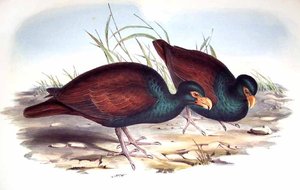SPREP calling on Savai'i uplands to become a protected area
SPREP says the Savai'i uplands should be listed as a protected conservation area after undertaking a biodiversity assessment of the area.
Transcript
 The Secretariat of the Pacific Regional Environment Project, or SPREP, is calling on the Samoan government to list the uplands of Savai'i as a protected conservation area and nominate it as a World Heritage Site.
The Secretariat of the Pacific Regional Environment Project, or SPREP, is calling on the Samoan government to list the uplands of Savai'i as a protected conservation area and nominate it as a World Heritage Site.
A group of scientists was recently airlifted to the top of Mount Silisili, where they camped for 10 days to survey the situation of flora and fauna and produce The Rapid Biodiversity Assessment of Upland Savai'i.
Mary Baines filed this report.
(Illustration of the Manumea - tooth-billed pigeon)
Between 1,000 and 1,800 metres above sea level, the dense cloud forest of the Savai'i uplands is largely unexplored by scientists and uninvaded by predators. An entomologist, Eric Edwards, discovered more than 40 moth species that have never been seen before, likely to be endemic to the highest parts of Savai'i. His team also found 36 species of landsnails new to science, and rediscovered some noted as extinct.
ERIC EDWARDS: This upland area in Savai'i, part of its naturalness is how uninvaded it is. Very few things have invaded there amongst the insect fauna. So that means the snail fauna is very intact. And so things that are extinct and are fossils that you find in the sand dunes around the Savai'i coastline - they're extinct at low altitude, but they're present in the upland. You know, that's something to be treasured.
A member of the bird team, Rebecca Stirnemann, says they found the uplands are possibly a refuge for the endemic, endangered Ma'om'ao - but the national bird, the manumea, has a far lower population than expected.
REBECCA STIRNEMANN: We were looking for the Manumea, which is a close relative of the dodo, and we were hoping that would be quite abundant there and we'd find the last refuge for the species. Unfortunately there was only one sighting, which means that the population was much lower than we were hoping it would be.
The expedition's organiser from SPREP, Bruce Jeffries, says if the area is actively managed, the wildlife has a good chance of looking after itself. SPREP's report recommends that the Samoan government increase conservation of the forests, raise awareness of environmental laws, manage the threat of invasive species and ensure sustainable eco-tourism. Mr Jeffries says it has also recommended it become a protected area.
BRUCE JEFFRIES: The government of Samoa needs in the first instance to put it on an indicative list - these are sites of significance within national boundaries. And it's not on the country's indicative list yet. And from that it could go through a nomination phase, and the nominations go to a world heritage committee.
The CEO for Samoa's Ministry of Natural Resources and Environment, Taulealeausumai Laavasa Malua, says the ministry is discussing the report and consulting the local community. He says the people of A'opo have customary land ownership, and use the forest for traditional practices.
TAULEALEAUSUMAI LAAVASA MALUA: The land is customary ownership and the government intends to secure areas of land that are to be reserved for conservation. And the key is to have the communities informed of the values and benefits of reserving the untapped forests that remain in the uplands.
Taulealeausumai says the upland forests have considerable potential for eco-tourism, which would be run by the local people. He says the people of A'opo village have been asked to come up with their own ideas for how the area should be managed and protected, which will contribute to the government's final plan.
To embed this content on your own webpage, cut and paste the following:
See terms of use.

